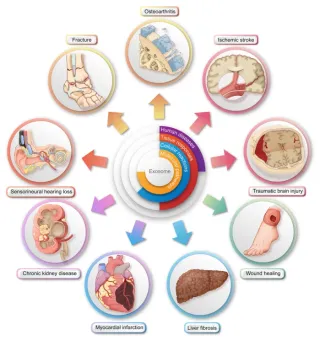Frequently Asked Questions
HOME /FAQ
From Science to Simplicity: Everything You Need to Know About Exosome Therapy
What are exosomes, and why are they considered part of the body’s natural healing process?
Exosomes are small extracellular vesicles released by cells that play a crucial role in cellular communication. They transfer proteins, lipids, RNA, and other molecules between cells, helping to regulate various biological processes. Because exosomes are a natural component of the body's cellular communication system, therapies based on them are viewed as harnessing and enhancing the body’s inherent healing mechanisms.

What is the significance of the natural composition of exosomes in therapy?
Exosomes contain natural biological molecules like proteins, lipids, and RNA that are essential for normal cellular functions. Their use in therapy emphasizes leveraging these naturally occurring components to enhance the body’s own healing processes, making the therapy more aligned with the body’s natural mechanisms. Exosomes are small extracellular vesicles released by cells, including MSCs. They are approximately 100 - 500 times smaller in diameter than the MSC's they originate from, allowing them to easily interact with and be absorbed by other cells.

What are Stem Cells?
Nature: Stem cells are undifferentiated cells capable of developing into different cell types, such as muscle cells, nerve cells, or blood cells.
Molecule Size: Mesenchymal Stem Cell is typically between 10 - 20 micrometers (µm) in diameter.
Function: They have the potential to self-renew and differentiate into specialized cell types, contributing to tissue repair and regeneration.
Role in Therapy: Stem cells are directly used in regenerative medicine to repair or replace damaged tissues or cells.
Are Exosomes considered Stem Cells?
No, exosomes are not considered stem cells. While exosomes can be excreted "derived" from stem cells and carry beneficial factors, they are not stem cells themselves. Instead, they are vehicles that transport important molecules that can influence healing and regeneration.
Nature: Exosomes are small extracellular vesicles released by cells, including stem cells, into the surrounding environment.
Molecule Size: Typically between 30- 150 nanometers (nm) in diameter.
Function: They contain and transport various biological molecules, such as proteins, lipids, and RNA, between cells, playing a role in cell communication and influencing various physiological processes.
Role in Therapy: Exosomes derived from stem cells (MSC-derived exosomes) are used to harness their regenerative and anti-inflammatory properties without using the stem cells themselves.
Are Exosomes considered minimally invasive?
Exosome therapy can be administered through various methods and are less invasive compared to traditional surgical or chemical treatments. This size difference is significant, highlighting the exosomes' role as nano-sized messengers that can carry molecular signals and therapeutic agents across cell membranes and barriers. This minimal invasiveness aligns with the concept of supporting the body's natural healing processes without major interventions.
How can Exosomes Therapy be administered? Read Article
Intravenous (IV) Injection - Description: Exosomes are injected directly into the bloodstream through a vein. Applications: Used for systemic effects where exosomes are intended to circulate throughout the body and target multiple areas, such as in cases of systemic inflammation or certain types of ailments. Benefits: Allows for widespread distribution of exosomes, potentially reaching distant tissues or organs.
Intramuscular (IM) Injection - Description: Exosomes are injected directly into a muscle. Applications: Suitable for targeting local areas of muscle injury or degeneration. Can be used in therapies for muscle repair or regeneration. Benefits: Provides localized delivery of exosomes to the muscle tissue.
Subcutaneous (Sub-Q) Injection - Description: Exosomes are injected into the layer of tissue just beneath the skin. Applications: Commonly used for therapies involving skin conditions or for localized delivery where a gradual release of exosomes is desired. Benefits: Allows for a relatively easy and less invasive method of administration.
Intra-articular Injection - Description: Exosomes are injected directly into a joint space. Applications: Used for treating joint-related issues, such as osteoarthritis or joint injuries, by delivering exosomes directly to the affected joint. Benefits: Targets the specific joint area, which can help in reducing inflammation and promoting repair within the joint.
Intrathecal Injection - Description: Exosomes are injected into the spinal canal, into the cerebrospinal fluid. Applications: Used for central nervous system (CNS) disorders, such as neurodegenerative diseases or spinal cord injuries. Benefits: Delivers exosomes directly to the CNS, which can be crucial for targeting brain or spinal cord issues.
Topical Application - Description: Exosomes are applied directly to the skin or mucous membranes. Applications: Used for skin conditions or wounds, where exosomes can be delivered through creams, gels, or other topical forms. Benefits: Provides localized treatment to the skin or mucosal surfaces.
*NEW (EXO DROPS) - Ocular (Eye) Administration - Description: This involves applying exosomes directly to the surface of the eye using eye drops. The exosomes are suspended in a sterile saline solution to ensure they are safe for use in the sensitive environment of the eye. Application: Eye drops are used to deliver therapeutic agents, such as exosomes, directly to the ocular surface, including the cornea and conjunctiva. Purpose: The goal is often to treat conditions affecting the eye, such as dry eye syndrome, inflammation, or to support healing and regeneration of ocular tissues. Ease of Use: Eye drops are a non-invasive and relatively simple method of administration that patients can use at home.
The injection method for exosome therapy varies based on the condition and treatment goals, allowing for targeted or systemic delivery. Consulting with a specialist prior to treatment is crucial to understand the best approach and optimize results.

How do exosomes contribute to tissue repair and regeneration?
Exosomes derived from mesenchymal stem cells (MSCs) have regenerative properties that aid in tissue repair and regeneration. They contain bioactive molecules that can influence cell behavior, promote healing, and support the repair of damaged tissues. Their ability to reduce inflammation and modulate immune responses further enhances their role in the natural healing process.
What are the systemic benefits of exosome therapy?
Exosomes have the ability to affect multiple aspects of cellular function and overall health. By targeting various pathways involved in healing and regeneration, exosome therapy supports comprehensive well-being and provides a holistic approach to treatment, addressing multiple factors from within.
what are types of industries or clinics that can utilize treatment of exosomes therapy?
Exosome therapy has diverse applications across various industries and clinics such as:
Regenerative Medicine and Stem Cell Clinics - Tissue repair and regeneration, treatment of degenerative diseases, and enhancement of wound healing. Examples: Clinics specializing in orthopedics, dermatology, and general regenerative medicine.
Neurology and Neuroscience Clinics - Treatment of neurodegenerative disorders (e.g., Alzheimer’s, Parkinson’s), stroke recovery, and brain injury repair. Examples: Neurology departments in hospitals, specialized neurorehabilitation centers, and research institutions focused on CNS disorders.
Ophthalmology Clinics Applications: Treatment of ocular diseases and conditions, such as dry eye syndrome, retinal disorders, and corneal injuries. Examples: Eye care centers, retina and cornea specialist clinics, and ocular research facilities.
Dermatology and Aesthetic Clinics: Skin rejuvenation, anti-aging treatments, and enhancement of wound healing. Examples: Dermatology practices, cosmetic surgery clinics, and aesthetic treatment centers.
Sports Medicine and Orthopedic Clinics: Treatment of sports injuries, joint repair, and muscle regeneration. Examples: Sports medicine centers, orthopedic clinics, and rehabilitation facilities.
Chronic Pain and Palliative Care Clinics: Management of chronic pain, inflammation reduction, and support for quality of life improvements. Examples: Pain management clinics, palliative care centers, and integrative medicine practices.
Research and Academic Institutions: Exploration of new therapeutic applications, development of exosome-based treatments, and advancement of cellular biology knowledge. Examples: Universities, medical research institutes, and biotechnology labs.
Are Exosomes FDA approved?
NO. As of now, exosomes themselves are not FDA-approved as standalone therapeutic products. However, their use in clinical applications is being explored, and there are some important considerations:
Like most vitamins and supplements available in stores, exosome therapies are not FDA-approved.
Most dietary supplements and vitamins do not require FDA approval before they are marketed, and the same applies to many exosome-based products which are often still in investigational or experimental phases.
Investigational/Experimental Use Only: Research Phase: Many applications of exosome therapy are still in the investigational or experimental stages. They are being studied in clinical trials to assess their safety, efficacy, and potential therapeutic benefits. Clinical Trials: Researchers are exploring the use of exosomes for various conditions, such as neurodegenerative diseases, cancer, and regenerative medicine. These studies must follow FDA guidelines for clinical trials.
For any therapeutic product, including exosomes, a full FDA approval requires rigorous testing and evaluation to ensure safety and effectiveness.
Why is exosome therapy considered to have a reduced risk of rejection?
Exosome therapy often involves using exosomes derived from the patient's own cells or closely related donor cells. This compatibility with the patient’s immune system reduces the risk of rejection compared to foreign substances or synthetic materials, making the therapy a more natural and integrated approach.
MSC-derived exosome therapy is generally considered safe, but potential risks and side effects can include:
Allergic Reactions: Rarely, patients may experience allergic reactions to the exosome preparation.
Infection: As with any therapeutic procedure, there is a minimal risk of infection if proper protocols are not followed by staff.
Immune Response: There is a possibility of immune system reactions, although MSC-derived exosomes are typically less likely to provoke such responses unlike other therapies.
Overall, exosome therapy is still under investigation, and ongoing research aims to further establish its safety profile and efficacy.
Why does the size of Exosomes matter and make it unique?
Due to their nano-size, exosomes can facilitate cell-to-cell communication and possess healing properties, allowing them to reach areas that larger cells, such as stem cells, cannot. This versatility enables more effective methods of administration for health and beauty treatments. Depending on application, Exosomes have the potential to cross the blood-brain barrier (BBB) in some cases, unlike larger cells. Additionally, exosomes can be administered through smaller needles, including insulin-sized needles, whereas stem cells typically require needles 23 gauge or larger as to not get damaged during the administration process.
EXOSOMES EXPLAINED!
Consult with a Healthcare Provider: Discuss with your doctor to understand the current state of research and what options might be available.
Stay Informed: Be aware that ongoing research might lead to new findings that could affect the safety and efficacy of exosome treatments.
Consider the Risks and Benefits: Ensure you are fully informed about the potential risks and benefits of undergoing exosome therapy.
Overall, many studies do not outright discourage exosome therapy but highlights that it is still under investigation and that patients should approach it
with a thorough understanding of its current limitations and ongoing research.
DISCLAIMER
This website and its content are for general informational and educational purposes only and are not intended to diagnose, treat, cure, or prevent any disease. PURE LLC operates as a Private Wellness Membership Association, offering resources, products, and support exclusively to its members.
Products such as Exosome Drops are formulated for personal wellness and self-directed care, and are not marketed as medications or therapeutic treatments. These offerings are made under private association protections and are not intended for use by the general public.
Exosomes and related biologics are currently being studied and are not approved by the FDA for the diagnosis or treatment of any medical condition. All materials and statements on this site are provided for educational purposes only.
Individual results may vary. If you experience any discomfort or have concerns while using any product, discontinue use and consult a qualified healthcare professional. Always speak with your healthcare provider before starting any new health, wellness, or supplement routine—especially if under medical supervision.
Contact: [email protected]
© 2025 | Privacy Policy
